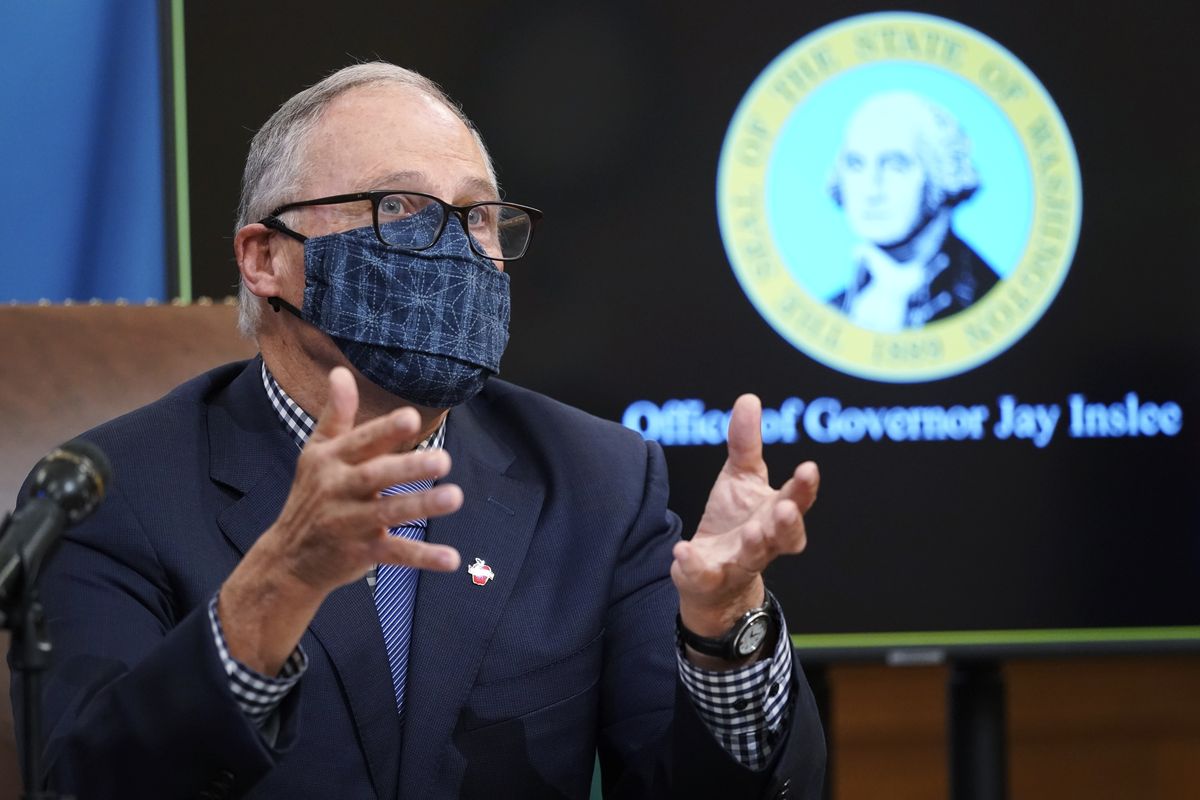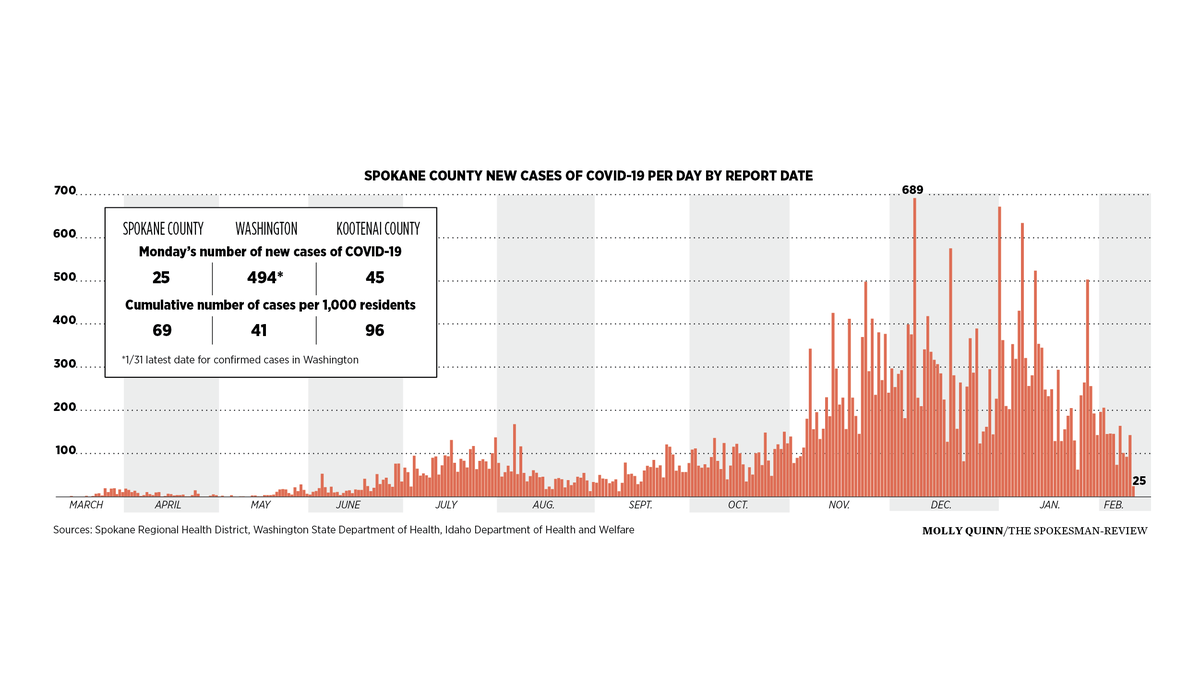Spokane to move to Phase 2 of reopening plan next week, just in time for Valentine’s Day
Washington Gov. Jay Inslee talks to reporters about COVID-19 restrictions at the Capitol in Olympia. (Ted S. Warren)
OLYMPIA – Spokane will move to Phase 2 in the state’s reopening plan on Sunday, allowing restaurants, gyms and entertainment establishments to open to 25% capacity, just in time for Valentine’s Day.
The state’s East region, which includes Spokane and eight other counties, will join most of the state in moving to the next phase, Gov. Jay Inslee announced Thursday. The regions now in Phase 2 make up 92% of the state population, with only the South Central region, which includes Yakima and the Tri Cities, remaining in Phase 1. The six counties in the South Central region won’t be able to move forward for at least the next two weeks.
Some in Spokane welcomed news that the economy could begin to reopen, but as new COVID-19 variants continue to spread nationwide, health officials reminded everyone to remain cautious.
“We believe this is a reasonably scientific-based decision,” Inslee said. “But we do realize there is some potential risk out there.”
To move to Phase 2, a region must meet three of the four metrics:
- A 10% decreasing trend in COVID-19 case rates;
- A 10% decrease in COVID-19 hospital admission rates;
- An ICU occupancy rate less than 90%;
- A COVID-19 test positivity rate of less than 10%.
Four of the state’s eight regions are currently meeting all four marks, which are evaluated by state health officials every two weeks. The East region has met all metrics except the seven-day test positivity rate, currently at 10%.
Regions can move backward a phase if their metrics begin regressing . Inslee said this allows the system to “self-correct” and protect against further outbreaks.
The regions will move forward on Sunday, one day earlier than originally planned, to accommodate restaurants that get a lot of business on Valentine’s Day. The new rules allow indoor dining at 25% capacity.
Along with indoor dining, fitness centers and indoor entertainment establishments can reopen to 25% capacity. Outdoor sports competitions are allowed with a maximum of 200 people, including players and spectators. Indoor social gatherings can resume, but only with a maximum of five people from two households. Outdoor social gatherings can now include 15 people from two households.
Spokane Mayor Nadine Woodward, who previously criticized the governor’s reopening plan, called Thursday’s announcement “exciting news.”
“Our region has done a tremendous amount of selfless work to put us in a position to advance,” Woodward said in a statement. “That includes many, many businesses that have struggled, sacrificed and carefully followed the public health guidance for the benefit of others.”
Still, Woodward cautioned the region not to rest on its laurels.
“Please continue wearing your mask, social distancing, limiting gatherings and supporting businesses as they follow the guidance. These are the habits that will get us past the pandemic,” Woodward said.
Two weeks ago, Inslee announced the Puget Sound and West regions, which include seven counties, could move to Phase 2. Those two regions will continue to stay in this phase for the time being. Currently, there is no third phase.
Josh Kerns, Chair of the Spokane County Board of Commissioners, reacted to Thursday’s news by immediately calling on Inslee to lay out a path toward further reopening.
“While entering into Phase 2 is positive news, we must allow our citizens to return to work and combat the mental health impacts of this shutdown by letting our struggling small businesses safely reopen at a quicker pace,” Kerns said in a statement.
Inslee said he had no indication of when a third phase would be developed and when regions could move.
Local restaurant owners have mixed reactions to reopening
For some fine dining restaurants, reopening at 25% capacity isn’t worth it. Wild Sage Bistro in downtown Spokane has been shut down completely, including for takeout, since Dec. 26 and won’t be reopening until it can serve diners at 50% capacity, according to the restaurant’s voicemail message.
Mike Jones, owner of Mizuna downtown, didn’t want to bother with takeout. Including all the expenses – rent, insurance, power to cool the fridges, ingredients, labor, and, he said, “I could go on and on,” takeout “just ends up being a spiral and you’re losing more money than it costs to close the doors.”
It also didn’t make sense for Mizuna’s menu items, which he said play on texture and temperature and need to be served right away. Once stuck in a box, he said the food’s separate properties just “become the same.”
He said the restaurant will reopen , and the staff that has stuck with Mizuna through shutdowns – about half of the front of the house and about a third of the kitchen – are “diehards” who love the work they do.
Jones is opening largely for them and to return some sense of normalcy.
“We won’t be breaking even,” Jones said. “It’s worth being open just to start moving in the right direction.”
Anthony Anton, president and CEO of the Washington Hospitality Association, called the announcement “great news for public health and for our industry.”
“In the areas of our state that have been reopened, we’ve seen cases continue to drop as gatherings have moved to regulated, safe establishments,” Anton said in a statement. “Yet we know we have more work to do: We must allow safe gathering spaces in every area of the state.”
For Adam Hegsted, owner of several local restaurants in Spokane and North Idaho, opening to 25% capacity is “better than nothing.”
The Yards Bruncheon is faring better than some, as comfort food translates to takeout, he said. Gilded Unicorn hasn’t because it is more experience-oriented, he said. His catering business has been “crushed.”
Meanwhile, his two Idaho restaurants, Honey Eatery in Coeur d’Alene and Republic Kitchen and Taphouse in Post Falls, have had “record days” as people flood in from Washington to eat out, Hegsted said.
To Hegsted, the shutdowns didn’t appear worth it for the public good. He felt COVID case numbers in Spokane are comparable to North Idaho’s, despite the different approaches with eating out. Kootenai County has had around 21,400 cases as of Thursday and Spokane County has recorded 35,800. Given the difference in the two counties’ sizes, the case rate in Kootenai is about double that in Spokane.
Jones at Mizuna said he would’ve liked to see restaurants stay at 50% capacity, but he’s rolling with the punches.
“When people’s lives are at stake, you should err on the side of safety,” Jones said. “When people’s livelihoods are at stake, it’s obviously not as bad as losing people’s lives, but it does have a lasting effect.”
Many of those who work at the restaurants and businesses that are now allowed to open have yet to be vaccinated. Essential workers and others in certain congregate settings will not be vaccinated for at least one more tier. Inslee said Thursday he does not believe these young workers would want to be vaccinated before their parents or grandparents who may currently be eligible.
“We respect your working,” he said. “We want to get you vaccinated as soon as we can. Hang in there, help is on the way.”
‘A race against time’
While small gatherings and restaurants and gyms with 25% capacity indoors are allowed in Phase 2, both state and local health officials have asked Washington residents to remain vigilant in combating the virus by wearing masks that fit properly and with many layers, limiting gatherings, getting tested and continuing to distance.
Secretary of Health Dr. Umair Shah told reporters Wednesday that “it’s a race against time,” as state health leaders balance several factors. While vaccinations are ongoing, doses are limited, and it will take several more weeks to finish offering doses to eligible residents in the current allocation phase. There is COVID fatigue statewide, Shah said.
There is also evidence of at least one variant of the virus that is more contagious in four counties in Washington.
There are 15 confirmed cases of the U.K. variant, B.1.1.7, in King, Snohomish, Pierce and Clark counties. Separately, the more contagious South African variant has made it to the West Coast, with the variant confirmed in two counties in northern California.
State Epidemiologist Dr. Scott Lindquist said Washington state is doing very high-level genotyping to look for and track the spread of variants in the state. Keeping the virus, including new variants, at bay will be key to ensuring that regions do not regress in the governor’s current Roadmap to Recovery phases, as well as preventing a fourth wave of the virus, health officials say.
The East region, which includes Ferry, Stevens, Pend Oreille, Lincoln, Adams, Whitman, Garfield, Asotin and Spokane counties, was grouped together in the Roadmap plan based on hospital and emergency medical services.
“Our biggest goal, the No. 1 factor and concern we had, is we also wanted to make sure our health care system did not surge,” Shah said in Spokane this week.
A decline in hospitalizations statewide and in Eastern Washington is a part of what enabled the region to advance in the new phases. It’s also what held the South Central region back in the phases. In the region, which includes Yakima, the Tri-Cities and Walla Walla, there are 75 patients hospitalized with the virus, or 12.7% of the occupied hospital beds in the region.
Here’s a look at local numbers:
The Spokane Regional Health District confirmed 25 new coronavirus cases on Thursday, although this number is not accurate due to data errors, and officials expect that count to be closer to 100 when the data is updated Friday.
There are 57 people with COVID-19 in Spokane hospitals, and the health district confirmed three more deaths on Thursday.
The Panhandle Health District confirmed 76 new cases on Thursday and no new deaths. There are 35 Panhandle residents hospitalized with the virus.
S-R reporter Adam Shanks contributed to this report.

